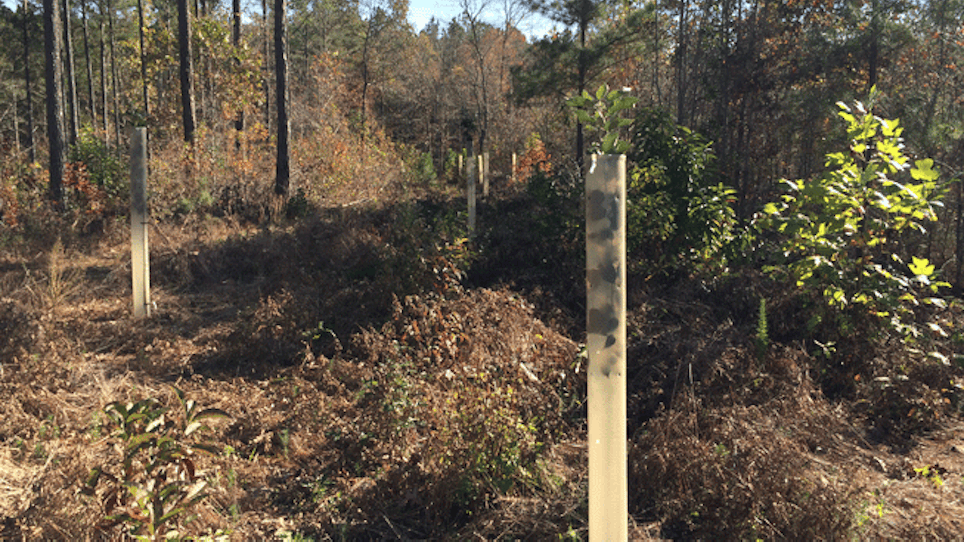When managing a hunting property for wildlife, many of the things done are investments in the future: Letting young bucks walk until 3½ to 4½ years old, conducting prescribed fires, planting fruit and mast producing trees, etc.
Fruit trees not only serve as an attractant, but they hold deer on your property and supply them with valuable high-energy calories and sugars, which help build critical fat reserves leading into winter. Our goal was to not only attract and hold more deer on our property, but to also create hunting spots for bow season and early rifle season.
We pinpointed secluded ridgelines to plant the majority our small hunting orchards. The hidden areas would hopefully allow deer to feel safe while feeding, thus encouraging daylight movement for hunting purposes. Ridgelines are also less susceptible to late frosts in the spring time when apple and pear trees are blooming and growing young fruit. Because colder air will pool in low-lying areas, these ridges might remain frost free during flower and fruit production.
Bob Wallace of Chestnut Hill Outdoors recently delivered 150 fruit and chestnut trees to our Borrowed Acres property in central Alabama. In the video, Wallace talks about the different varieties of fruit trees and why they benefit wildlife managers. We selected more late-dropping varieties of fruit trees to ensure they would be dropping their delicious mast during bow season — which in Alabama doesn’t start until October 15 — through early rifle season.
The trees we selected for Borrowed Acres.
Grafted Persimmons: The two variety offered by Chestnut Hill are Deer Candy (early-dropping persimmon) and Deer Magnet (late dropping). The Deer Candy variety begins dropping fruit in August through October. The Deer Magnet holds its fruit until October and drops through November. Wallace suggest planting both varieties together for good pollination and for extended fruit production from August through November. Both of these varieties are grafted females, which means every tree will produce fruit, unlike wild persimmons that can be male (non-producing trees) or female. These grafted varieties were selected because they are heavy producers, too.
Apples: Wallace suggested we plant Arkansas Black and Winesap apples. The Arkansas Black variety are very disease resistant, which is important in the South where fire blight and other diseases are persistent. Arkansas Black apples also ripen late into November and December, making them ideal for hunting orchards. Winesap is another late-dropping apple that is resistant to disease. Winesap and Arkansas Black are companion varieties that will pollinate each other.
Pears: The Thanksgiving pear variety is extremely resistant to disease and holds its fruit until Thanksgiving and early December. It’s a highly attractive fruit to deer and other wildlife.
Dunstan Chestnut: The Dunstan chestnut tree is a cross between the American chestnut and the Chinese chestnut, which makes it resistant to blight. It’s a heavy producing hard-mast tree with sweet tasting nuts loaded with carbohydrates and protein, unlike acorns which consist mostly of oils and fats. When I told Wallace I wanted to order 150 fruit trees, he suggested we make half of the order Dunstan chestnuts, because of their nutritional value for deer and other wildlife. Our goal is to plant a number of these along the drive into the property and other large open areas to provide deer with loads of quality food. Because nutrition was our main goal with the chestnut trees we didn’t worry about putting these in secluded areas to encourage daytime feeding.
Checkout Chestnut Hill Outdoors to see all the other variety of fruit and mast trees they have available for wildlife. We chose varieties that were highly disease resistant, which require as little maintenance as possible and that would grow well in our Southern climate. Be sure to choose trees that will grow the best in your climate zone. In 3 to 5 years our trees will start dropping sweet and nutritious fruit and chestnuts on the ground and the deer will be waiting to vacuum them up!






